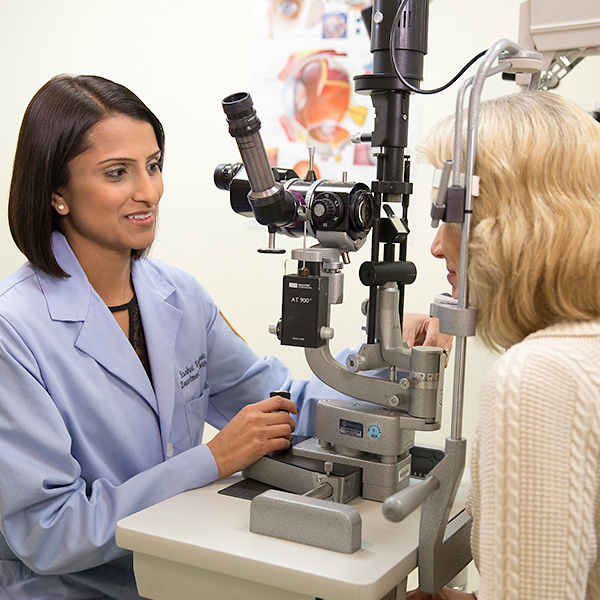Strabismus (Crossed or Misaligned Eyes)
Integrated Clinical Care for Strabismus
Loyola Medicine’s ophthalmologists have the skills and expertise to correct crossed or misaligned eyes, a condition called strabismus. Loyola’s ophthalmologists have completed thousands of successful strabismus surgeries and restored patients’ vision and appearance.
Strabismus is an eye muscle imbalance in the six muscles that work together to control each eye. Nearly four in 100 adults have strabismus; in most cases, adults have had strabismus since childhood.
People with strabismus can have an eye that crosses, an eye that drifts outward or upward or lazy eyes. In some cases, strabismus is not readily visible, but it may be the cause of double vision or recurring eye strain.
The condition also can begin in adulthood due to medical conditions such as diabetes, Graves’ disease, myasthenia gravis or a stroke. Occasionally, strabismus develops following surgery performed on or around the eye for other issues such as cataracts or retinal surgery. Corrective treatment allows for:
- Expanded peripheral vision
- Improved eye alignment
- Improvement or restoration of the use of both eyes together
- Reduced eye fatigue
- Reduced or eliminated double vision
Additionally, the ability to look others directly in the eyes may be the greatest emotional reward from strabismus correction.
Specialized Ophthalmology Services at Loyola
Loyola’s ophthalmology program provides care for men, women and children of all ages in outstanding, conveniently located facilities. We have multidisciplinary facilities at Loyola University Medical Center, in addition to outpatient services at other locations. We offer the following specialized services to provide you with the most comprehensive care:
- Neuro-ophthalmology — Our highly experienced neurologists and ophthalmologists provide clinically integrated care for eye conditions that are related to the nervous system. Neuro-ophthalmology, a subspecialty of both neurology and ophthalmology, requires specialized training and expertise in problems of the eye, brain, nerves and muscles.
- Oculoplastics and orbital surgery — Loyola’s surgeons have advanced training in reconstructive, ophthalmologic and cosmetic eye surgery for the eyelids, eyes, eyebrows, orbital cavity and lacrimal (tear duct) system, as well as the cheeks and forehead.
- Pediatric ophthalmology — Loyola’s pediatric ophthalmology program is dedicated to diagnosing and treating vision disorders and problems in infants, children and adolescents. We take a multidisciplinary approach to care, bringing together the expertise of pediatric ophthalmologists, pediatric eye surgeons, optometrists, certified orthoptists and certified ophthalmic assistants.
What Treatment Options are Available for Strabismus?
The goal of strabismus treatment at Loyola is to restore normal, functional alignment of the eyes. Initial treatment may include the use of eyeglasses, patches, eye exercises or medical eye drops. If these methods are unsuccessful, surgery often is the next option.
Many patients defer strabismus surgery for years, even though they are very bothered by the problem. Patients with crossed eyes since childhood or double vision have been mistakenly told that strabismus surgery does not work in adults—but the vast majority of these adults can have their strabismus safely improved by surgery.
Strabismus surgery to straighten the eyes is safe and effective in both children and adults, despite widespread misconceptions to the contrary. Surgery is performed on an outpatient basis and usually only takes about one hour. Patients go home with no eye patches and return to work or school in about one week.
Loyola’s skilled ophthalmologists are experienced in caring for patients with strabismus and offer the latest non-surgical and surgical treatments, including:
- Adjustable sutures — Using adjustable sutures during and after surgery helps reduce the risk of under- or overcorrection in adults.
- Optometric vision therapy — Through training and rehabilitation of the eye-brain connections involved in vision, this non-surgical treatment is intended to improve eye alignment, eye teaming, eye focusing abilities, eye movements and visual processing.
- Orthoptics — Your doctor may recommend eye muscle training exercises to address eye teaming (helping the eyes move together) and visual clarity. This treatment can create lasting results.
- Strabismus surgery — Treatment techniques for adults are similar to those used in children: the muscle or muscles are exposed, then either weakened or strengthened as needed to produce the new ocular alignment and function.

